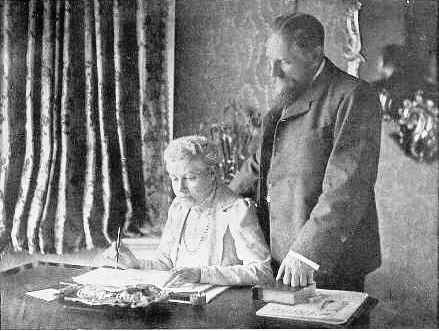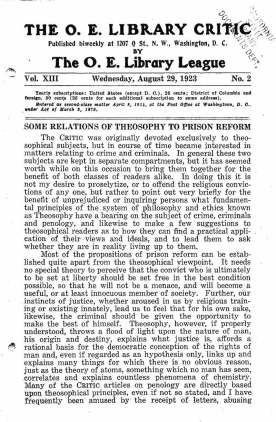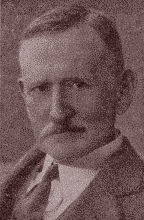There cannot be the shadow of a doubt that Mrs. Besant and her associates have long since abandoned the original Theosophy and have substituted a spurious Theosophy of their own, in large measure directly contradictory. This is not the place to go into details, but a few examples will be given presently.

It is easy enough to see what causes have led up to this condition in the Theosophical Society. Two persons are responsible, Mrs. Besant and the scheming C. W. Leadbeater. While drawing constant attention to themselves in innumerable statements with which theosophical literature is filled, by placing persons who would sing their praises in prominent places, by forcing their own writings on theosophists and discouraging those of the founders, they have succeeded in casting out H. P. B. and the Mahatmas and have put themselves in their place. At the same time they have made use of the well-known fact that most people will accept what it is easy and pleasant to believe irrespective of its truth, and will follow those handing it out to them. By giving people what they like and backing it up with claims of clairvoyant insight, contact with the Masters and what not, by bestowing honors and initiations, so-called, on those who give promise of being useful to them, they have raised themselves to a sacrosanct position and have secured a large following.
Theosophy is a strong man’s religion. It states in the most unmistakable terms that progress is by self-induced and self-devised efforts, that whatever progress one makes must be made by oneself and cannot by any possibility be conferred by another; that there is no such thing as shifting one’s sins upon another. It is inexorably opposed to the doctrine of vicarious atonement in any form, and therefore does not appeal, as does church Christianity, to the shirkers and slackers who want to enjoy the pleasures of sin while casting the responsibility upon a redeemer, nor does it attract the weak who want to have “force” poured into them rather than seeking it in themselves.
The present leaders have exploited this human failing to the utmost. Instead of encouraging their disciples to stand on their own feet, they have encouraged them to be led and have held themselves up as the leaders, as the divinely appointed shepherds, and then, having caused them to renounce all spiritual and intellectual independence they have filled them to the neck with everything that was condemned by the Masters. It was announced that the only way to progress beyond a certain point was to begin with a pledge of blind obedience to Annie Besant; they have stimulated a desire to come into personal contact with Masters and then have put themselves forward as the only ones able to secure them such a privilege. In fact, Leadbeater tells us (“The Masters and the Path,” page 59) that the first step to a Master is to believe in Annie Besant and to think of her constantly in one’s meditations. Leadbeater had himself announced as being “on the threshold of divinity,” while Annie Besant actually printed and circulated a letter written by one of her sycophants, George Arundale, declaring that she is to be the “ruler of gods and men.” Leadbeater wrote an absurd book on the astral plane, clearly a work of imagination, and then gave out that the Master K. H. was so delighted with this work that he secured the original manuscript for the occult library of the White Lodge (“Theosophist,” February, 1919, page 419). In 1913 these two worthies published “Man: Whence, How and Whither,” a preposterous travesty on the Theosophy of the Masters, which was clearly intended to supplant “The Secret Doctrine,” and which actually attempted to do so by designating it as a product of dubious clairvoyance. Leadbeater produced those absurdities, “Rents in the Veil of Time” and “The Lives of Alcyone,” in which, as well as in “Man: Whence, How and Whither,” he appealed to the vanity of his dupes and bound them more closely to them by assigning them important roles in past lives, and connecting them up by marriage with himself, Annie Besant and Krishnamurti. About the same time he started an Initiation mill, pretending that certain persons whom he wished to make use of had taken initiations with the Masters, and holding out the hope to others that they might receive the same honor if they would but follow him – “All these things will I give thee, if thou wilt fall down and worship me.”
The notion of the near coming of a world teacher, the reincarnation of Christ, and the selection of young Krishnamurti to fill the role was a relatively harmless vagary, although it contravened a definite statement of H. P. B. to the effect that there would be no new teacher till about 1975, and tended to withdraw attention from the teachings which were already available. A far more pernicious innovation was the Liberal Catholic Church which, even had it not been founded upon fraud by a gang of disreputable sex-perverts, and had it not used every sort of fraud to force itself upon public attention and especially upon that of theosophists, was in direct conflict with the teachings of H. P. B. and the Masters, leading its followers to depend upon ritual and priestly ceremonial for their advancement. The doctrines of this church of magic and smells, sanctified grease, holy water and other humbuggery, as presented by Leadbeater and endorsed by Mrs. Besant, amount to a virtual denial of Theosophy. Leadbeater told us that sin is a “twist in the ether” (“Theosophist,” September, 1917), which will automatically straighten itself in time, but cannot be corrected by any effort of the sinner himself; only a priest, by use of the ceremonials peculiar to the church, can rectify it. Here we have a flat contradiction of the doctrine of Karma, a basic principle of Theosophy. He further announced that “power,” or what Christians call “the grace of God,” is something which no one can secure by his own efforts or worthiness, but that a priest of “apostolic succession” can secure it for him by muttering certain prescribed incantations by which an astral pipe is run up, and “Christ himself,” standing at the top pours the force or grace down through it, with the aid of an assisting angel. From the priest it is sprinkled over the congregation and even over the surrounding country for miles around – a sort of theosophical April shower, wetting alike the just and the unjust. This force or grace of God he described as a sort of electricity which could be stored in reservoirs and liquified and distilled in a suitably constructed still, and so gross was the picture he drew of it that one might expect it to be bottled and served from door to door like the morning milk (“Theosophist,” April, 1920, pages 55-63). These are no exaggerations; they are literally what he tells us in his book, “The Science of the Sacraments” and in a series of articles published by Mrs. Besant. We were even told that the devotional attitude was now becoming obsolete, that “the wave of devotion is receding and the wave of ceremonial rising,” and that while it is desirable that the priest who hands out the grace of God in the above fashion shall be a moral man, this is by no means essential, in fact quite a secondary consideration.
One looks for such stuff among voodooists, and in churches which deal in mechanical processes of salvation by proxy, but not in a society which once held that “Each man is his own absolute lawgiver, the dispenser of glory or gloom to himself, the decreer of his life, his reward, his punishment.” It is a direct repudiation of real Theosophy, of what every spiritually minded person must perceive to be self-evident, and yet, with and by the consent of Annie Besant, and with her public endorsement and her threats in the E.S. [i.e. Esoteric Section], it was and is being insidiously forced into theosophical lodges.
Those familiar with the methods of propaganda followed know how these changes have been effected. First, through Mrs. Besant’s E.S., backed by threats of expulsion and loss of advancement in future lives; then, by using the official machinery to bring the writings of H. P. B. into discredit and to push their own books instead. Official lecturers, selected from the most ardent followers of Besant and Leadbeater, went out of their way to state publicly that Blavatsky was too difficult to understand and recommending instead the books of these two leaders. “The Secret Doctrine” was kept carefully out of the way on top shelves or in the locked closet, to be consulted only at such times as nobody had the chance to read it; Blavatsky books were to be purchased only by special order, and were even falsely reported to be out of print; Besant and Leadbeater books were hawked about and kept on sale on lodge book tables, under the charge of trusted persons. A “Primer of Theosophy” was placed in the hands of new members, containing a list of books recommended by Leadbeater, who advised reading 23 books by Annie Besant and 10 books by himself before attempting to touch, if at all, H. P. B.’s “Secret Doctrine,” and even this they were discouraged from studying.
With the authority of Mrs. Besant the Adyar press issued a booklet for new members in which precisely the same tactics were followed. The whole was clearly enough a deliberate scheme for scuttling Blavatsky, substituting their own corrupted Theosophy and selling their own books.
From comments by Dr H. N. Stokes, published in his monthly periodical The O. E. Library Critic Vol. XVI, No. 10, May 1927.

Most issues of The O.E. Library Critic are available on-line at: http://blavatskyarchives.com/stokesoelc/stokes_list.htm and http://www.iapsop.com/archive/materials/o_e_library_critic/

Henry Newlin Stokes (1859-1942) was a Theosophist, occultist and humanitarian. In 1905 he began a free lending library of occult material, and for a time the library and this journal functioned as adjuncts of the Oriental Esoteric Center of Washington, the society started by Miss Agnes E. Marsland to propagate the secret Tibetan teachings of “Dr. de Sarak.” In 1910, Sarak tried from Paris to exercise control over the Washington Center (and its finances) and the Center was re-organized as the “Oriental Esoteric Society” to exclude him. He promptly retaliated by canceling the charter of the Center and expelling its head, Miss Agnes E. Marsland. She, in turn, in 1912, laid claim to the library that had been affiliated with the Center/Society. This led to another lawsuit, from which Stokes emerged victorious. The journal then separated itself from the Society (see the comment in the issue of July 17, 1912) and continued as an outspoken advocate of prisoners’ rights and opponent of “Neo-Theosophy” (Theosophy as taught by Annie Besant, Charles Webster Leadbeater, et al., as contrasted with the “original” version expounded by H.P. Blavatsky). The O.E. Library Critic is essential reading for the history of Theosophy because of Stokes’s publication of innumerable original documents on the Theosophical Society.
http://www.iapsop.com/archive/materials/o_e_library_critic/
See: James A. Santucci “H.N. Stokes and The O.E. Library Critic” Theosophical History Vol I No 6 April 1986. Available on-line at: http://www.theohistory.org/thcovers/thscan106.html#Anchor-13458